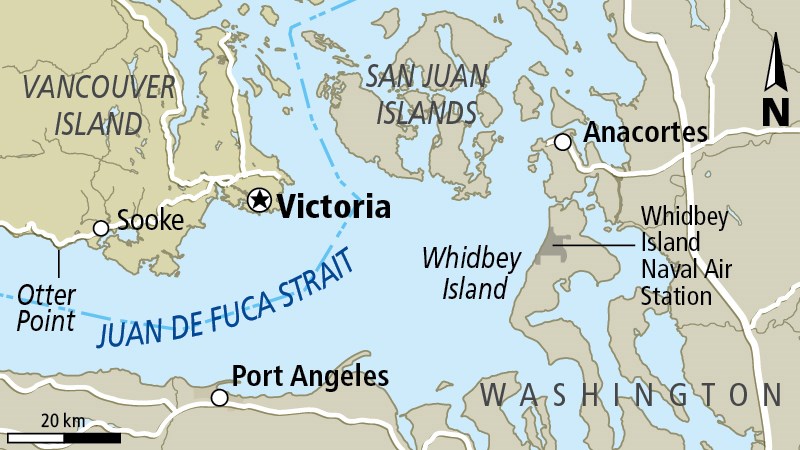 The Rumbles were particularly loud Tuesday evening. As usual, they sounded like a heavy truck rolling past, or God bowling, or the beginning of an earthquake. Only this time they were intense enough to send you cowering under the coffee table with the dog, in case this really was the Big One.
The Rumbles were particularly loud Tuesday evening. As usual, they sounded like a heavy truck rolling past, or God bowling, or the beginning of an earthquake. Only this time they were intense enough to send you cowering under the coffee table with the dog, in case this really was the Big One.
Miesha Knorr detected the Rumbles in Central Saanich, thought they might have something to do with the fog and circling airplanes.
Meagan Hogg heard them in Fernwood, where they have been known to interrupt her sleep.
On Pender Island, Mae Moore wondered if the noise was from a U.S. Coast Guard firing exercise planned for the Whiskey Hotel gunnery range on the Canadian side of Juan de Fuca Strait. Jonny Miller asked the same thing. But no, as it turned out, the coast guard didn’t do any shooting that day.
The Rumbles — mysterious, intermittent low murmurs lasting up to 30 seconds at a time — have occurred on and off for a few years, most frequently in the southern Gulf Islands, down the east side of the Saanich Peninsula and into Oak Bay — though Tuesday’s reports came from as far as Colwood.
While the more imaginative among us blame everything from aliens to acid flashbacks, the noise is most often linked to EA-18G “Growler” electronic-warfare aircraft based at Whidbey Island in Washington state. Although the base has been around since the Second World War, the rise of the Rumbles coincided with the arrival of the Growlers in 2008.
Sure enough, the U.S. navy confirms the jets were flying out of Whidbey’s Ault Field on Tuesday evening, the pilots practising the type of landings they would do on aircraft carriers.
Why so loud this time? Well, sound is funny that way. Saanich ham radio operator Colin Newell offers this explanation: “Temperature variations, humidity, atmospheric pollution and winds can all have an effect on how a subsonic shock wave or acoustic disturbance is perceived on the ground.” Even the calmness of the ocean surface can have an effect. Note that the navy says the Growlers’ engines aren’t actually louder than their predecessors, but their sonic frequency is lower. To those of us who are scientifically illiterate, what all that means is, given the right conditions, it can be “like having a Woodstock-era concert on an adjacent Island with Black Sabbath on the main stage every night,” Newell writes.
Understandably, the Rumbles become a bigger deal the closer you get to the source: a rare curiosity in the West Shore, an occasional minor annoyance on the Peninsula and a cause for consternation in the Gulf Islands, where Pender’s Miller called Tuesday’s episode “sonic abuse.”
The noise has become a source of some serious snarling in the San Juans, where local authorities set up websites to field complaints and a delegation went to the other Washington to pester politicians and the Pentagon. On Whidbey Island itself, where one homeowner claimed vibrations caused $14,000 in window damage, a residents’ group sued in 2013.
But there’s also plenty of support for the Growlers. The navy provides two-thirds of the island’s jobs and pumps $1 billion into the economy. When the Seattle Times wrote about the complaints in November, some online comments said the noise of the Growlers — whose electronic arsenal is used to jam the enemy’s radar and otherwise mess up its communications — is the sound of freedom. “I suggest all your neighbours get themselves an American flag and hang it outside their house to show support to those brave young men and women risking their lives for us,” read one. “I bet you don’t have an American Flag … DO YOU?”
Don’t expect the Rumbles to subside soon. The Whidbey Island Naval Air Station is home to 82 Growlers, with more on the way. The spending bill passed by Congress in December included $1.5 billion for 15 more of the aircraft, and that’s on top of 13 that were previously approved, though U.S. navy spokesman Ted Brown said it’s uncertain when they’ll arrive at the Washington base.
The additions prompted the navy to launch what it calls an environmental-impact statement, a process that included public hearings in the San Juans and on the Olympic Peninsula in November and December. The results of the analysis are due in 2016.



